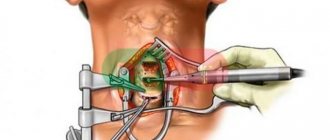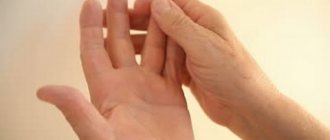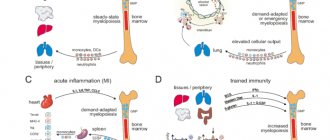- Numbness of the little finger of the left hand
- Numbness of the little finger of the right hand
- Causes
- Treatment for numbness of the little finger
Many patients, when visiting a doctor, do not know how to correctly interpret their complaints.
For example, when a specialist asks if there is numbness in the little finger, people are confused, not knowing what it is. Numbness is a decrease or complete loss of sensation. Numbness can be subjective and objective. Subjective numbness is an internal sensation of the patient who seems to be losing sensation. Objective, when a specialist, using medical equipment or a diagnostic examination, confirms the lack of sensitivity.
Objective and subjective numbness is an important diagnostic sign of various diseases. For example, with some psychological problems, such as hysteria, patients describe numbness, but this symptom is not observed objectively.
Most common reasons
Numbness that lasts a short period of time is not dangerous. Particular attention should be paid to long-term symptoms, including headache, dizziness and sudden loss of consciousness.
Are your fingers going numb—the little finger and the ring finger? The reasons may be the following:
- hernia;
- Raynaud's disease;
- osteochondrosis of the lower cervical region;
- diabetes;
- bearing a child;
- injuries to the head, upper arm or cervical spine;
- climacteric condition;
- carpal tunnel syndrome;
- multiple sclerosis;
- atherosclerosis.
It is important to remember that the fingers contain many small nerve endings that very quickly react to any external influence. Systematic numbness of the fingers is a good reason to contact a treating specialist, since wasting time in the presence of dangerous diseases can lead to serious consequences.
How to treat numbness in fingers
There is no single course of therapy. To begin with, the doctor examines the patient, finds out the true cause, and only after that can make some therapeutic prescriptions.
Treatment of numbness in the fingers and toes is always long-term, since first they get rid of the root cause (treatment of the underlying disease) and only after that they begin to restore the blood supply to the fingers and toes.
A feeling of numbness in the fingers of the lower and upper extremities can be a physiological norm and a symptom of a developing disease. If such a condition occurs once and does not recur with enviable regularity, then no specific treatment will be required. Regular numbness in your fingers is a reason to immediately visit a doctor and undergo a full examination.
Related services: Consultation with a neurologist Cardiological Check-up
Pinched nerve in the neck
Doctors call numbness in the little finger as carpal tunnel syndrome or compression of the nerve in the elbow. The nerve fibers that provide sensation to the fingers originate in the spinal region. Eight pairs of cervical nerve roots arise from the spinal cord and then go to the intervertebral foramen. It is the eighth spinal nerve that is responsible for the sensitivity of surrounding objects from the beginning of the forearm to the little finger. Excessive stress on this nerve can lead to numbness.
Herniated discs and arthritis are the most common causes of pinched nerves in the cervical spine. The vertebrae are separated by special discs that can become displaced, changing their normal position, and form a hernia. A hernia formed below the seventh cervical vertebra significantly increases the load on the eighth spinal nerve, which results in a decrease in the overall sensitivity of the little finger.
Over time, the free space between adjacent vertebrae begins to decrease. Arthritis provokes an inflammatory process in the intervertebral joints, reducing the gaps through which the nerve roots pass. Arthritis between the seventh vertebra and the first thoracic vertebra increases the load on the eighth cervical root, leading to numbness in the fingers - the little and ring fingers.
Carpal tunnel syndrome
The spinal roots branch into a large number of nerves that give sensation to the muscles of the arms. The ulnar nerve originates in the eighth cervical and first thoracic nerve roots. It runs between the muscles along the inside of the elbow and provides sensation to the forearm, little finger and ring finger. When exposed to physical force (for example, hitting something hard), the structure of the nerve fibers is disrupted, which leads to a feeling of numbness. In this case, two fingers go numb at once: the little finger and the ring finger. In this case, the person feels as if he is receiving an electric shock.
Some muscle pressure can lead to increased pressure on the elbow nerve. Most often, this happens when the muscles and tunnel structures compress the nerve, causing the little finger and ring finger of the left hand to go numb. The condition of the ulnar nerve can worsen if the elbow is injured or if prolonged stress is placed on it (for example, if you lean on the surface of your arm for a long time).
Pinched nerve
The ulnar nerve fibers run along the inner forearm and then pass through a tunnel, which is otherwise called Guyon's canal. It is through the little finger that the nerve enters the hand. When a nerve is pinched in the elbow area or when carpal tunnel syndrome occurs, the sensitivity of the little finger is greatly deteriorated. Increased stress on the nerve in Guyon's tunnel can be caused by diseases of the blood vessels, tumor processes, arthritis and cystitis. All this leads to the fact that the fingers on the hand go numb: the little finger and the ring finger.
Why do my big toes go numb?
Numbness of the fingers of the lower extremities can be caused by physiological and pathological reasons. Many people experience this sensation when wearing tight shoes or in an uncomfortable sitting position (for example, a leg tucked under the buttocks). Such numbness is not pathological and disappears immediately after restoration of blood supply to the numb part. Regularly numb big toes during sleep or in a comfortable position (sitting, lying down) indicate disturbances in venous blood flow. The condition in question is often a symptom of varicose veins of the deep veins of the lower extremities, which must be treated with medications and physical therapy under the supervision of a specialist. Why do my toes go numb at night? The reason is a violation of the blood supply to small vessels. This condition can be corrected, so with the help of drug therapy it is possible to quickly get rid of the problem.
In addition, numbness in the fingers of the lower extremities can be caused by problems in the functioning of the heart, which is fraught with the most serious consequences, including heart failure and death.
Receiving microtrauma
Short nerve endings (up to three millimeters in diameter) entangle the fingers in a network. Physical impact on any of these nerves can result in numbness of the little finger in the area where the injury occurred.
Microtraumas most often occur due to injury or traumatic exposure. In these cases, surgery is most often necessary to restore damaged nerves and restore the previous sensitivity.
Additional reasons
Are your fingers going numb—the little finger and the ring finger? The reasons may be the following:
- Serious illness. Loss of sensitivity in the little finger may indicate the presence of a disease. For example, diabetes can damage nerve endings. This process is called diabetic neuropathy. This disorder usually occurs when blood sugar levels remain high for a long time or when blood circulation is poor.
- The result of a stroke. With numbness in the hands and partial paralysis, there is a high chance of having a stroke. This diagnosis is considered very serious and therefore requires urgent medical attention. The little finger may lose its former sensitivity due to a stroke. Blood clots or damaged blood vessels interfere with normal blood circulation. Sudden loss of sensation or a burning sensation in the fingers, especially in only the right or only the left hand, may indicate a stroke. If you have such symptoms, it is important to consult a doctor as soon as possible for a diagnosis.
- Carpal, ulnar neuropathy. The little finger and ring finger of the right hand go numb, most often due to neuropathy. Most people are right-handed, so it is their right hand that bears the greatest load, which leads to injury to the ulnar nerve and numbness in the fingers.
- Raynaud's disease, in which the hands become cold and blue, is not fully understood. Multiple hand injuries can lead to this disease. Numbness in most cases is localized at the ends of the fingers in cold weather due to a sudden spasm of the blood vessels.
- Multiple sclerosis, which occurs due to disruption of the integrity of the myelin sheath of neurons, also leads to numbness of the limbs. But in this case, the patient has a peculiar gait.
- Carpal tunnel syndrome has the following symptoms: numbness of the hands, tissue swelling, loss of sensation, pain. This syndrome occurs most often in people who, due to their specialization, must perform the same movements throughout the day. If treatment is not started promptly, carpal tunnel syndrome can lead to atrophy of the thumb.
- During menopause, as well as when carrying a child, the fingers begin to go numb due to tissue swelling, which often leads to compression of the nerve bundle in the wrist area. If symptoms occur frequently, it is important to carefully examine the cardiovascular system.
Carrying out diagnostics
When visiting your doctor, it is important to describe in detail all the symptoms and signs of discomfort in your hand. A detailed description of numbness will help to conduct a proper examination and make an accurate diagnosis.
If the right little finger and ring finger are numb, then it is best to pay increased attention to the functioning of the heart muscle. In the morning, the patient has a tingling sensation on one side. The main symptoms appear later: the little finger and ring finger go numb at night.
- A feeling of numbness in the middle finger indicates a lack of certain vitamins in the body. In this case, experts advise completely changing your diet, and, if possible, going to see an endocrinologist.
- If the index finger of the left hand is numb, it is important to pay attention to possible narrowing of blood vessels or the presence of diseases in the cervical spine.
- Is the little finger and ring finger of your left hand going numb? The cause may be osteochondrosis. To make an accurate diagnosis, it is important to see a doctor. If you have osteochondrosis, you need to start treatment immediately, as the condition can quickly worsen.
- The ring finger on the right hand may lose sensitivity due to excessive fatigue. In this case, it is best to just rest. This often happens to women who do any kind of needlework.
- Numbness in the middle finger of the right hand requires the help of an orthopedist. In most cases, this symptom indicates damage to the elbow joint.
- Numbness of the thumb on the right hand indicates the presence of carpal tunnel syndrome.
- When there is numbness in the little fingers on both hands, it is immediately important to pay increased attention to the functioning of the internal organs and systems.
- The two thumbs lose sensation if any of the problems described are present. If, against the background of numbness, the patient has impaired fine motor skills, an unsteady gait, or weakness, then it would be best to undergo examination in the neurological department.
- If the little finger and ring finger on both hands become numb, this indicates a complication of cervical osteochondrosis. It is important to contact a specialist in a timely manner.
Pain and numbness in the fingers may indicate serious illness
Photo: coalcreekpt.com
Many people complain of numbness in their fingers and pain that wakes them up at night and interferes with full-time work. However, not everyone goes to the doctor when the disease has not yet progressed so far, and irreversible changes can be avoided. We talk with orthopedist-traumatologist at the Medical Center for Diagnostics and Treatment, Simonas SAREIKA, about which symptoms should cause concern and in which cases surgical intervention is necessary.
– What hand and wrist diseases do patients most often present with?
– These are mainly diseases caused by pinched nerves - carpal and ulnar tunnel syndromes, as well as diseases caused by inflammation of the tendons - the so-called “snapping” finger and tenosyvitis of the radius. Joint diseases, pain in the hand, and disorders of the subcutaneous structure are common.
The most common and well-known tunnel syndrome is carpal tunnel syndrome (from English - “carpal tunnel syndrome”), i.e. compression of the median nerve under the transverse carpal ligament, which occurs between the three bony walls and the tight ligament that hold the tendons of the muscles that flex the fingers and hand. Carpal tunnel syndrome and diseases caused by inflammation of the tendons are more often diagnosed in women over 50 years of age or in young people burdened with heavy physical work. They cannot sleep at night due to numbness and pain in their fingers. During the holidays, these symptoms most often subside. Wrist pain sometimes appears after an injury, gradually intensifies and begins to interfere with everyday life. Cubital tunnel syndrome affects both men and women over 30 years of age. Dupuytren's contracture (palmar fibromatosis) - painless scar degeneration and shortening of the palmar tendons - is inherited, more often observed in smoking, physically working men over 60 years of age.
– How do the symptoms of these diseases differ?
– With carpal tunnel syndrome, the fingers go numb at night, pain appears in fingers 1-4, and they are stiff in the morning. At the initial stage, the numbness goes away after waking up, but as the disease progresses, it remains, and objects begin to fall out of the hands, and it becomes difficult for the patient to fasten buttons, although at night there may be no pain at all.
Elbow joint syndrome most often manifests itself only in numbness of the fingers, less often in pain at night. 4-5 fingers are damaged. As the disease progresses, the muscles of the palm weaken and strength disappears.
The main cause of stenosing tenosynovitis (“snapping” finger) is pain in the hand. The palm begins to hurt when you move your fingers. The pain spreads to the forearm. As the disease progresses, it becomes more difficult to straighten the finger, it “gets stuck”, and a characteristic sound appears - a click, which gave the popular name to this disease. Sometimes the finger does not straighten at all, then you have to return it to its place with the other hand. Snapping finger syndrome is caused by a nodule in the extensor tendon. Most often, patients have damaged fingers 1, 3, and 4.
Dupuytren's contracture is manifested by the inability to straighten the fingers and nodular thickening of the skin on the palms. At first it may be painful, then changes occur in the fingers - it is impossible to straighten them.
Wrist hygroma (hernia) is a small, rounded protrusion under the skin. Occurs as a result of a sharp turn with a load or after heavy physical exertion. Because of this formation, patients most often turn to a hand surgeon. A “bump” seems to grow on the hand, this really scares people.
Diseases of the joints of the hand and wrist are very complex, which is why a thorough examination is necessary.
– What is the cause of this or that disease?
– The most common cause is excessive physical activity or injury, as a result of which the tendons become inflamed, enlarged, begin to injure other tissues, and pinch nerves. After an injury, joints begin to wear out faster. Hormonal changes and, oddly enough, everyday habits also have an impact, for example, while sleeping, take a position with strongly bent arms, while working, constantly resting your elbows on the table, and for drivers, on the edge of the car door. The causes of some diseases are not completely clear.
– What symptoms should lead a person to see a doctor?
– You should always contact a specialist if your fingers gradually or suddenly become numb - this is a sign of a pinched nerve, also if a tumor has appeared and begins to grow. When a person does not consult a doctor due to diseases manifested by numbness of the fingers, night pain, the nerve is damaged more and more - the fingers lose sensitivity, the muscles of the hand begin to atrophy, the hands weaken, it becomes difficult to grasp small objects, the hands are afraid of the cold. In this case, even after surgery, hand function may not be fully restored. If the finger gets stuck and the disease progresses, even after surgery, movement may remain limited.
Very often, it is difficult for patients to name clear symptoms, so conditions in which the nerve is pinched may remain undiagnosed for a long time. By applying on time, the patient can receive qualified help. A very informative diagnostic test in these cases is electroneuromyography, which helps to determine the extent and amount of damaged tissue.
– What are the tactics for treating these diseases?
– At the initial stage, these diseases are treated conservatively. If this does not help, the doctor decides whether surgery is required. It is important that the patient comes in on time. Operations carried out in a timely manner are simple and very effective. When the disease is advanced, the effectiveness of operations is not so high.
Conservative treatment of carpal and ulnar tunnel syndromes boils down to reducing physical stress on the arm, prescribing non-steroidal anti-inflammatory drugs, B vitamins that improve blood flow and nerve nutrition, vasodilator drugs, and splinting. Electroneuromyography helps diagnose these diseases and determine treatment tactics.
I most often begin treatment for trigger finger with hormonal blockade with Kenalog. When treating tenosynovitis, a splint and hormonal blockade are prescribed. The neoplasm - in the case of hernias of the wrist, finger joints, tendons - is punctured. Changes in the wrist joints are treated with splints, anti-inflammatory drugs, physiotherapeutic procedures, and injections into the joint.
– When is surgery necessary?
– Always with Dupuytren’s contracture, in other cases – if conservative treatment methods do not help, and the symptoms persist or progress.
The operations are reimbursed by the Health Insurance Fund, so the patient does not have to wait in line and goes to any clinic that can perform such an operation, for example, to our Center. After all operations, the patient is discharged home on the same or the next day. The main thing is not to hesitate at the first symptoms in order to prevent serious illnesses.
For any questions, please contact your personal manager Beata Putrameneta by phone 2 (Russia, Viber, WhatsApp) or by email. by mail, as well as by the general number of the department for receiving foreign patients: +370 5 247 63 69
Diagnostic procedures
The main goal of diagnostic measures is to establish the cause of numbness, as well as the possibility of pathological changes in the body. First, the patient must donate blood for laboratory testing, which will help identify the presence of toxins. This analysis is especially important for those who work in enterprises with increased harm to the body.
From hardware research the following is used:
- X-ray of the cervical spine;
- magnetic resonance imaging;
- Dopplerography of arterial vessels of the neck and spine;
- computed tomography;
- echoencephalography.
Each of these methods helps to obtain additional information about the patient’s condition, which makes it possible to make an accurate diagnosis, as well as create an effective treatment.
Using a special x-ray, you can take a series of pictures that will help determine exactly where the damage to the nerve roots and blood vessels is widespread. Doppler ultrasound of the arteries is important for assessing the general condition of the vessels. It uses ultrasound radiation, which does not cause any discomfort to the patient.
Using MRI and CT, the spinal column and brain are carefully examined. Echoencephalography, which uses ultrasound, helps to accurately determine the size of the pathological process that occurs in parts of the brain. Sensors installed next to the skull produce ultrasonic waves of a certain frequency and perceive echoes. Currently, such research is used only in hospitals that do not have computer or magnetic resonance imaging.
Electroencephalography helps to identify even minimal changes in brain function. Electrodes attached to the head are connected to a device that detects all changes in the electrical activity of the waves and gives readings on the monitor in the form of a broken line.
The results of diagnostic procedures and an accurate study of all the patient’s symptoms of illness help the doctor to correctly determine the cause of numbness in the fingers and prescribe the appropriate treatment.
Diagnostics
Thus, there are quite a lot of diseases that can provoke hypoesthesia of the fingers. Therefore, if this symptom occurs regularly and persists for a long time, you should definitely consult a neurologist. The doctor will conduct a survey and examination of the patient, during which he will assess the condition of the skin, pulse strength, reflexes and conduct certain neurological tests to detect possible motor disorders. But to make an accurate diagnosis, this data is not enough. Therefore, depending on the detected signs, patients may be prescribed one or another diagnostic procedure from the following:
- electromyography and electroneurography - used to assess the degree and extent of damage to nerve trunks;
- X-ray or CT - used to detect deformities of the bones of the hands, tumors;
- angiography is a method used to assess the quality of blood circulation in the area of interest, in particular for diagnosing Raynaud's syndrome;
- Dopplerography of the vessels of the neck and head - is prescribed to detect cerebral circulation disorders and vascular pathologies;
- MRI is used to detect minute changes in soft tissue structures, the brain, and intervertebral discs.
A set of laboratory tests is also often prescribed, the results of which help to identify systemic diseases, for example, diabetes mellitus, anemia, endocrine disorders, rheumatoid diseases, etc.
Which doctor will help?
Due to the fact that there are a large number of reasons for the loss of sensitivity in the fingers, it is important to seek help from several specialists at once who could accurately determine the source of the lesion: a surgeon, a neurologist, a cardiologist. All of them must conduct a full study, as a result of which it will be possible to prescribe correct and effective treatment.
Most often, therapy comes down to doing therapeutic exercises, taking medications and using external ointments.
Therapeutic measures
In each individual case, individual treatment is required. For osteochondrosis and carpal tunnel syndrome, massage of the collar area and a complex of physical therapy help to cope with the problem. Special physical exercises are used to develop atrophied muscles after a hand injury.
Taking medications in each case will go well with manual therapy, taking a vitamin complex, and physiotherapy. Treatment with ultrasound, laser and magnetic therapy helps improve blood circulation and has a positive effect on all regeneration processes.
Non-traditional methods are also widely used in therapy: vacuum procedures, hirudotherapy, acupuncture.
To avoid numbness in your fingers, it is important to follow some preventative measures:
- avoid wearing heavy things for a long time;
- walk more;
- introduce into your diet as many products as possible containing vitamins B12;
- during monotonous work, it is important to take a break for physical activity;
- avoid severe stress;
- get rid of bad habits (stop drinking alcohol and smoking);
- dress warmly when it's cold outside.
All the recommendations described will help significantly reduce the chance of loss of sensitivity in the fingers, and will reduce the risk of vascular diseases and damage to nerve fibers.
What to do if your little finger and ring finger are numb
The treatment regimen for numbness of the upper extremities is selected depending on the background of the disease against which this symptom developed.
If the numbness was due to physiological reasons, no treatment is required; the numbness usually goes away when the causative factor, for example, excessive load on the limb, is eliminated.
In other cases, the patient may be prescribed:
- Drug therapy: non-steroidal anti-inflammatory drugs, analgesics, vitamin-mineral complexes, etc.
- Physiotherapy: laser, magnetic, ultrasound therapy, phonophoresis, massage, physical therapy, acupuncture.
- Correction of the musculoskeletal system: in some cases it is necessary to immobilize the wrist (for example, using an orthosis).
If the problem cannot be resolved with conservative therapy, the patient may need to undergo surgery.
General recommendations
If numbness occurs due to prolonged work at the computer or other activities, you must:
- Take regular breaks, relaxing your hands as much as possible.
- Perform special exercises for fingers and hands.
If your hands are numb, it is recommended to give up bad habits, get a good rest (ensure a good night's sleep), strengthen your immune system, and avoid hypothermia. Patients may need to limit their salt intake; it is recommended to enrich their diet with vegetables, fruits, dairy products, and nuts.
Folk remedies
| Traditional method of treatment | Explanations |
| Hand baths | Baths with honey, milk, infusions and decoctions of medicinal herbs for 10-15 minutes, as well as contrast baths (usually the procedure is recommended to be carried out once a day for at least 10 days) |
| Tincture of pickled cucumbers and hot peppers | The product is rubbed into the affected limb before going to bed (3 chopped pickles, 3 hot peppers, 500 ml of vodka, leave for 1 week and filter) |
| Boiled pumpkin | Boiled pumpkin is applied to the brush, which is covered with polyethylene and woolen cloth on top |
| Compress with honey | Numb hands can be lubricated with honey, wrapped in polyethylene and a warm cloth, and left the compress overnight |









